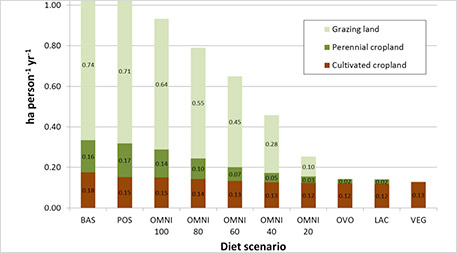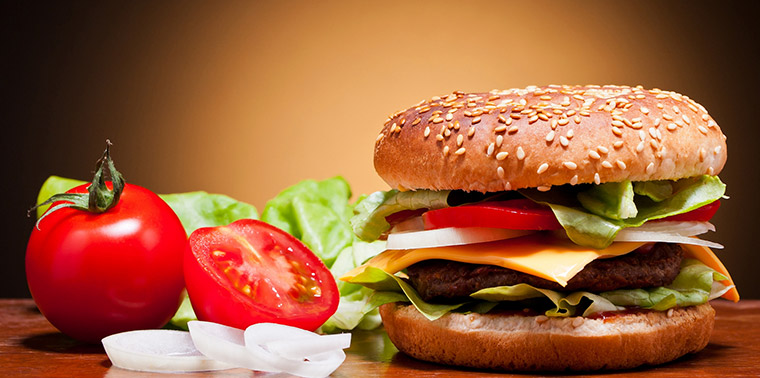July 22, 2016 —  Editor’s note: This piece was produced in collaboration with the academic journal Elementa. It is based on “Carrying capacity of U.S. agricultural land: Ten diet scenarios,” published July 22 at Elementa.
Editor’s note: This piece was produced in collaboration with the academic journal Elementa. It is based on “Carrying capacity of U.S. agricultural land: Ten diet scenarios,” published July 22 at Elementa.
Vegetarian? Omnivore? Vegan? What should we eat if we want to feed a growing population while minimizing the need to farm more land? We know that meat-based meals require more farmland than plant-based ones. But which diet is the best fit for the mix of croplands and grazing land that supports agriculture today? That’s a different question with a potentially different answer, since much of the land we use to produce our food is better suited for grazing livestock than growing crops.
 A new study published in Elementa explores this perplexing question of the “foodprint” of different diets. Researchers calculated how much land is needed to feed people under 10 diet scenarios ranging from conventional American to vegan. The study considered land currently farmed throughout the entire continental United States and looked at not only the amount of land needed to support each diet, but also how much of the available land each scenario could use.
A new study published in Elementa explores this perplexing question of the “foodprint” of different diets. Researchers calculated how much land is needed to feed people under 10 diet scenarios ranging from conventional American to vegan. The study considered land currently farmed throughout the entire continental United States and looked at not only the amount of land needed to support each diet, but also how much of the available land each scenario could use.
The 10 scenarios included a diet based on current U.S. food consumption patterns and another that reduced fats and sweeteners to bring the calorie level in line with U.S. Department of Agriculture’s 2010 Dietary Guidelines for Americans. The remaining eight scenarios maintained healthy calorie levels but moved toward increasingly vegetarian eating patterns, including ovo-lacto vegetarian, lacto vegetarian and vegan.
The baseline diet — what Americans are eating today — required the most land at 1.08 hectares (2.67 acres, or more than two football fields) per person per year, followed by the reduced-fats-and-sweeteners diet at 1.03 hectares (2.55 acres) per person per year. Land requirements decreased steadily as the proportion of food derived from animals declined, with the three vegetarian diets requiring 0.13 to 0.14 hectares (0.32 to 0.35 acres) per person per year.

The amount of grazing land, perennial cropland and cultivated cropland needed to support different diets varies widely. Image courtesy of Elementa. Click to expand.
Since production of different types of food requires different types of agricultural land, researchers distinguished among three distinct categories of land: grazing land, cultivated cropland and perennial forage cropland. They found that the five diets containing the largest quantities of meat used all of the available cropland and grazing land. The five diets containing little or no meat still used the maximum available area of cultivated cropland but varied widely in their use of forage and grazing land. The vegan diet relied solely on the land suited to growing crops, using none of the available grazing or forage land.
When the number of people who can be fed from the available agricultural land was estimated, results revealed that reducing meat in the diet increases the number of people who could be supported by existing farmland. Estimates of the number of people who could be fed ranged from a 402 million people for the “business as usual” diet to 807 million people in the lacto vegetarian scenario. The vegan diet, surprisingly, fed fewer people than two of the omnivore diets and both of the other vegetarian diets, suggesting food choices that make use of grazing and forage land as well as cropland could feed more people than those that completely eliminate animal-based food from our diets.
The researchers concluded that a strategic shift toward a plant-based diet could reduce the amount of land needed to feed U.S. consumers and at the same time increase the number of people who can be fed from our agricultural resources. The result could be more food — without the need to clear more land — for hundreds of millions of people around the globe. ![]()
Ensia shares solutions-focused stories free of charge through our online magazine and partner media. That means audiences around the world have ready access to stories that can — and do — help them shape a better future. If you value our work, please show your support today.
Yes, I'll support Ensia!

It's unfortunate that the study focused on the carrying capacity math (penalizing the vegan scenario for somehow wasting the unused grazing land), obscuring the bigger picture conclusion, and handing the anti-vegan crowd a misleading factoid.
The vegan diets may be beneficial for many adults, but not for children and also not necessarily for the elderly.
Interesting side note- no strictly vegan diet is workable without the insects that grow on the foods and get eaten, usually unknowingly. Virtually no plant foods produce vitamin B12 and have low levels of several other vitamins. Following the diet requires great care in choosing foods for adequate nutrition. Vitamin B12 and others only come from animals of one sort or another.
Most farmers know that the best way to utilize land is a combination of crops on the best land, forage foods on more marginal land, crop rotation, grazing to harvest from land that cannot be cropped.
Regarding Phil's comment on plant foods having low levels of several other vitamins, That is completely false and actually very much the opposite. Aside from B12 and D (vitamin D we get directly from the sun), plant foods have much higher levels of vitamins and minerals on average than animal foods. B12 supplements are easily produced in the lab from bacteria. We only need 0.000876 grams of B12 each year. So no need to incorporate animal food in our diet just to get this small amount.
https://ndb.nal.usda.gov/ndb/search/list
Ovo and lacto vergetarian diets are even worse than meat containing diets because they are byproducts of the exact same exploitation. Most of the meat production is from dairy animals. Vegetarians just choose to throw the meat away.
In a vegan world all cultivated grasland vanishes to make room for forests and 80% of food production can be omitted completely. The animals raised and killed by vegetarians and meat eaters alike eat 4.5 times the amount of food as all people on this planet together (UN/IPCC).
The facts: https://climatehealers.org/the-science/the-facts/
I still think every geografic , climatic, should be taken in consideration.
In the conclusion, the vegan diet uses some more agriculture land than some other diets.
but the other diets use a lot more of grass land , pastures...
in some areas , some cases pastures are more or less ecological situations. in many other cases they are really destructive., for biodiversity, use of carbon and also deforestation.
most of grazing lands where once forest.
only small portion of grassland was grass before human intervention.
and most of the catastrofical clearance of tropical forest is for animal base products.
but true in some parts animal pasture land is very positive: mediteranean climat, to reduce the incidence of fire, mountains, where grazing animals goes there in summer.
Also in some places the hield of grass is very high due to perfect conditions : rich soil, regular rainfalls...
I am sure that technology will be able to feed many more people, maybe one day even without using land .
But will the other factors be ok?
every day we have 240.000 more people on earth .
make a small calculation of what will it be in 100 years.
about double of our population up to 16 billions .
My point is something has to be done now if we want to avoid catastrofical consequenses.
As most of us are very egoistical, and even if we are kind and generous, we mostly thing about our immediate future or about our children or grand children .
we rarely think about 100 or 500 years years from now.
reduce the increase in population, laws to penalise use of excessive resourses...
many solutions, but most of these solutions are not easy to apply, and will take away some of our freedom, some of our priviledge.
Thank you for the article and grafic, very instructive.
I love to see results addressing not just area but suitablity for production. Go grazing land! This use dramatically increases productivity overall, and feeds more with less otherwise not used, why wouldn t we?
That ignores the most important point. Of land that is usable for food production, only 5-10% (depending on country) can be used for agriculture with 3% presently used as permanent cropland. But 100% can be used to raise animal foods. Why are we limiting our analysis to the small percentage of presently and potentially usable land that is agricultural?
That other 90-95% includes includes savannahs, shrublands, tundra, forests, wetlands, mountains, rough foothills, rocky islands, arid areas, and deserts where one can sometimes graze cattle but certainly graze animals other than cows; such as chickens, goats, pigs, camels, alpacas, etc. Much of this falls under the category of 'rangeland' that by itself is half the earth's land surface